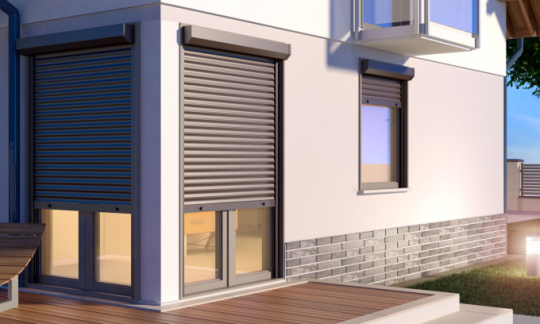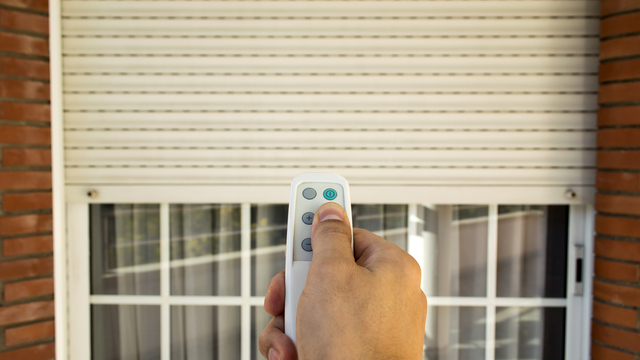Lock & roll: How much do roller shutters cost?
If you are thinking about installing indoor or outdoor roller shutters you may want to know about their features and the costs involved.

If you are thinking about installing indoor or outdoor roller shutters you may want to know about their features and the costs involved.
KEY POINTS
- Roller shutter price estimates range from $300 to $1,000, with an extra 30% on top if you have customised colours.
- Manual shutters can cost between $300 to $725, while electric shutters can cost between $500 to $1,000.
- Some shutters also require a licensed electrician, which could add to your overall costs.
What are roller shutters?
Roller shutters are blinds for your windows which operate like a roller door. They are typically made up of a series of smaller slats which are joined together and run on tracks. The shutters are wound around a cylinder that turns to lower or raise them either manually or via a motor. Roller shutters can be installed on the interior or exterior of a window in a range of sizes and colours.
How much do roller shutters cost?
Depending on the size, quality and design of your roller shutters, trade-sourcing website hipages estimates the cost as between $300 and $1,000. For example, a smaller roller shutter that is operated manually generally costs around $300 and $350, whereas a larger electric powered roller shutter will likely set you back around $690 to $1,000.
The price of roller shutters can also vary depending on the city where you live. According to Ultimate Shutter, Melbourne, Adelaide and Perth have the most window roller shutter suppliers, making prices there a little less. Sydney and Brisbane on the other hand have less competition, which means roller shutter costs may be higher.
What factors may affect the cost of your roller shutters?
Ultimate shutter also says that the price of shutters will reflect the quality of the product, so if you want a ore high-end product, you may need to be prepared to pay a premium for more high-quality and durable parts. That said, cost of your roller shutters may vary depending on several factors:
Interior or exterior
Roller shutters can be installed either inside or on the exterior of the building. Both offer degrees of protection for your home, like security and protection against UV damage. While both interior and exterior shutters can incorporate various design elements, exterior shutters are generally better for weather resistance.
Function
Roller shutters can provide weather resistance or added security, as well as provide a certain aesthetics to your dwelling. For example, if you live in a cyclone-prone area your roller shutters may be on the exterior of your home to protect your windows from flying debris. Hipages advises that roller shutters that are designed to be cyclone resistant generally cost around $200 more than standard domestic models.
Material
The material you choose for your shutters may be determined by their purpose, which will affect the cost:
- Aluminium: Aluminium is the preferred material for insulating purposes as they are designed to increase the energy efficiency of a home while also looking good. Aluminium roller shutters are customisable and may be powder-coated to a colour of your choice, depending on the manufacturer.
- PVC: PVC is a durable, shock resistant plastic. While sturdier and likely to last longer than aluminium, these types of shutters are not suitable for protection against bushfires. Factory Direct Shutters says that, while PVC shutters can be a cheaper option, they may be less durable and more prone to damage than other kids.
- Steel: Steel is the most secure material available, however it’s generally the most expensive. Steel roller shutters are also heavier than those made from other materials. This could mean that installation is more difficult and therefore more expensive.
Manual, automatic or battery power
Manual shutters are usually the more affordable option, with hipages estimating the cost between $300 to $725 a unit, depending on the size. On the other hand, electric shutters are estimated to cost between $500 and $1,000. And these numbers exclude installation costs. Battery-powered roller shutters are the most expensive and are generally $50 more than their electric counterparts. However, you may end up saving money on electricity and installation as they don’t need a licensed electrician to install. Battery-powered roller shutters also still work automatically during power outages, which may be beneficial during cyclones and other severe weather conditions.

Size
The size of your roller shutters will also affect the cost. Larger roller shutters generally cost more than smaller shutters. The main reason for this being that larger shutters require more material than smaller ones.
← Mobile/tablet users, scroll sideways to view full table →
| Shutter size | Estimated cost of manual shutters |
Estimated cost of automatic shutters |
|---|---|---|
| 600mm high x 800mm wide |
$300 | $500 – $660 |
| 800mm x 1200mm | $350 | $550 – $725 |
| 1200mm x 1800mm | $500 | $690 – $840 |
| 1800mm x 2400mm | $725 | $900 – $1000 |
| Source: hipages.com | ||
Installation
Roller shutters can be installed by a professional or you may choose to do it yourself. An obvious benefit of DIY is that you save yourself labour expenses (this may not be an option if you’re looking to install electric shutters). If you are hiring someone to install your roller shutters for you, keep in mind that the level of difficulty for the installation may affect the cost of the job.
Who can install roller shutters?
While roller shutters generally don’t require a licensed professional to install, electric or overhead shutters may require installation by an electrician or other appropriate professional. The safest bet is to check with the manufacturer when you purchase shutters. If you do use a professional roller shutter installer, make sure that they have valid insurance and a builders licence, keeping in mind that licensing requirements may vary between states and territories.
What are the pros and cons of roller shutters?
Here are some potential pros of installing roller shutters:
- Improve your home’s insulation: A popular reason for installing roller shutters is the insulation benefits they may provide. Better thermal insulation in your home will reduce heat or cooling loss, which could reduce your power bills.
- Provide extra security: If you are installing your roller shutters for security reasons, you might find that it benefits your home insurance as well. Not only can the design of your shutters protect your home from break-ins and vandalism, it can provide an immediate and visible deterrent for burglars. Increasing your home’s security can potentially lower your insurance premiums.
- Provide UV protection: Roller shutters can act as a physical barrier between harmful UV rays and the contents of your home, which may mitigate the sun damage to your furniture and belongings.
- Block out unwanted noise and light: Roller shutters can help block out noise and light. This can be helpful if you have trouble sleeping, live on a bright or noisy street or do shift work.
- Protect your home from extreme weather: Depending on where you live, you might benefit from bushfire or cyclone-rated roller shutters which are generally made of insulated aluminium or heavy steel. These types of blinds undergo extensive testing in accordance with the Commonwealth Scientific and Industrial Research Organisation (CSIRO). Shutters are graded against the Bushfire Attack Level (BAL) and tested on their ability to withstand radiant heat and flying debris. If you live in an area that is cyclone or fire prone, these added protection measures may also reduce your home insurance premiums.
Explore → How to make your home more energy efficient
Here are some cons of installing roller shutters:
- Difficulty cleaning: You may find it difficult to clean your shutters as the horizontal slats may require specific equipment. Shutter blinds on the outside of the house can generally be hosed off, but cleaning interior roller shutters may prove to be fiddly.
- Operating your shutters: Both automatic and manual roller shutters can be difficult to operate at times. Manual shutters don’t always operate very quickly or smoothly, particularly with age or if they have been out of use for a while. Whilst automatic shutters require sufficient power to operate which may be expensive and prove to be a problem in power outages.
- Aesthetics: Not everyone will like the look that roller shutters create for your home, and there are only so many ways you can stylise shutters. However, you might find that their practical benefits outweigh the aesthetics.
- Reduced light levels: As roller shutters are generally made of opaque materials, they often don’t allow light to pass through and could even completely block out all natural light in the house.
What are the options to finance roller shutters?
How you finance the purchase and installation of roller shutters may depend on how much it costs. There are several options available:
Offset, redraw or savings
If you’re hoping to avoid taking on any debt, you can finance the project with your own saved funds. You may also be able to withdraw money built up in a home loan’s offset account or redraw facility. But money saved in an offset facility reduces the interest you’re liable to pay, so you may want to check the effect accessing this money could have on your home loan in the long run.
Personal loan
Depending on your personal circumstances and the cost of the job, you might consider using a personal loan to fund the work. This could be a secured loan, or an unsecured loan. It’s worth keeping in mind though, that interest rates are generally higher for personal loans than for home loans. It’s a good idea to read the documentation associated with the loan to make sure you understand the conditions of the loan, the fees and the repayment schedule.
Credit card
It may also be possible to pay for the purchase and installation of your new roller shutters on a credit card. There could be some fringe benefits for doing so, such as extra insurance cover in some cases. Make sure you read the card’s Product Disclosure Statement to find out the conditions of the insurance cover. There will likely be a Key Facts Sheet document for details of the card itself. The various fees associated with a credit card are also something to be aware of beforehand. Keep in mind that credit card interest rates can be much higher than home or personal loans, so it could be a good idea to weigh up your options before deciding what action to take.
Cover image source: Studio Harmony/Shutterstock.com
This article was reviewed by our Editor-in-Chief Nina Rinella before it was updated, as part of our fact-checking process.

Alasdair Duncan is Canstar's Deputy Finance Editor, specialising in home loans, property and lifestyle topics. He has written more than 500 articles for Canstar and his work is widely referenced by other publishers and media outlets, including Yahoo Finance, The New Daily, The Motley Fool and Sky News. He has featured as a guest author for property website homely.com.au.
In his more than 15 years working in the media, Alasdair has written for a broad range of publications. Before joining Canstar, he was a News Editor at Pedestrian.TV, part of Australia’s leading youth media group. His work has also appeared on ABC News, Junkee, Rolling Stone, Kotaku, the Sydney Star Observer and The Brag. He has a Bachelor of Laws (Honours) and a Bachelor of Arts with a major in Journalism from the University of Queensland.
When he is not writing about finance for Canstar, Alasdair can probably be found at the beach with his two dogs or listening to podcasts about pop music. You can follow Alasdair on LinkedIn.
The comparison rate for all home loans and loans secured against real property are based on secured credit of $150,000 and a term of 25 years.
^WARNING: This comparison rate is true only for the examples given and may not include all fees and charges. Different terms, fees or other loan amounts might result in a different comparison rate.
 Owner occupied
Owner occupied
 20% min deposit
20% min deposit
 Redraw facility
Redraw facility
Try our Home Loans comparison tool to instantly compare Canstar expert rated options.





